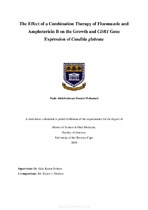| dc.description.abstract | Candida glabrata (C. glabrata/ Cg) is a pathogenic organism that is increasingly developing frank innate and acquired resistance to the most commonly used antifungal agents, namely, azole group of antifungals. Furthermore, C. glabrata-associated oropharyngeal infections affecting immunocompromised patients, are more difficult to treat and the development of resistance worsen the prognosis.
Molecular studies related the emergence of resistance in C. glabrata to the upregulation of ATP-binding cassette (ABC) transporter genes, which work by reducing drug concentration within the cell via drug efflux mechanism, and among these genes, CgCDR1 is considered to play a major role in resistance development. Thus, in order to overcome this problem, several combinations of antifungal agents are being studied.
Aim: To evaluate the effect of a combination therapy of fluconazole and amphotericin B on the growth and CDR1 gene expression of C. glabrata.
Research design and methodology: This in-vitro study evaluated the effect of a combination therapy of fluconazole and amphotericin B on the growth of C. glabrata and related it to the expression of CgCDR1 resistance gene. C. glabrata was revived in brain heart infusion (BHI) broth and later inoculated onto agar plates. Following overnight incubation, 5 colonies were transferred using a sterile loop into 2 ml of phosphate buffered saline (PBS) solution to establish McFarland (Mcf) standard. Later, the solution was diluted by transferring 200 μL to 400 ml of yeast peptone dextrose (YPD) agar (flask 1). From (flask 1), 90 ml, 99 ml and 89 ml of inoculum were allocated into 3 separate flasks, into which 10 ml fluconazole, 1 ml amphotericin B and 11 ml combination (10 ml fluconazole + 1 ml amphotericin B) were added, respectively. The inoculums were left to settle for 20 minutes, then incubated at 37oC with serial dilutions carried after 30 minutes, 2, 4, 6 and 24 hours. From the 96-microtiter plate, 10 μL for each treatment arm and time interval were transferred from selected wells and onto 30 Casein-peptone Soymeal-peptone (CASO) agar plates, and incubated for 24 hours. After incubation, the number of colonies were counted using an automated colony counter, to establish colony forming unit (CFU)/ml.
CgCDR1 gene expression was analyzed using real time polymerase chain reaction. After 6 hours of incubation, a sample was taken from each treatment arm, transferred into CASO agar plates and incubated for 24 hours at 37oC. After establishing Mcf, gene extraction and gene expression were carried out according to manufacturer’s instructions.
Results and discussion: No significant difference between the effect of the combination and amphotericin B was evident regarding C. glabrata growth. However, the combination therapy was more effective against C. glabrata than fluconazole, with a marked decrease in candidal growth at 30 minutes and 6 hours. Furthermore, the expression of CgCDR1 gene at 6 hours contact time was more pronounced in the samples of C. glabrata treated with the combination therapy, compared to that of the monotherapy.
Conclusion: The combination therapy had better effect on the growth of C. glabrata than fluconazole monotherapy. On the other hand, the expression of CgCDR1 was detected in the samples of C. glabrata treated with the combination therapy, suggesting the ability of the yeast to adapt and develop resistance in such environment. | en_US |

